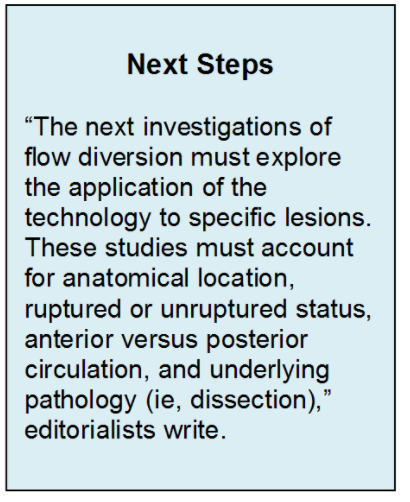Key Points:
- Study combines randomized and registry data to compare flow diverters and standard management for treating intracranial aneurysms
- Trial stopped early due to high morbidity and mortality with flow diversion

Using flow diversion to treat intracranial aneurysms results in higher-than-expected rates of morbidity and mortality and lower-than-expected rates of complete aneurysmal occlusion, according to results from a prematurely stopped trial published online November 4, 2016, ahead of print in the Journal of Neurosurgery.
The study demonstrated “worrisome complications from flow diversion, but no clear superiority of any treatment for aneurysms of any type,” write Jean Raymond, MD, of Notre-Dame Hospital (Montreal, Canada), and colleagues.
“The sample sizes were small and a final verdict would be premature. However, the burden of proof remains on flow diversion,” they conclude. “Flow diversion may be more prudently offered within a trial that makes it transparent that we are proposing a novel treatment under investigation, particularly when standard management options are possible.”
For the Flow Diversion in the Treatment of Intracranial Aneurysm Trial (FIAT), which was conducted at 3 Canadian centers, the investigators randomized 78 patients with intracranial aneurysms to flow diversion or standard management, which included observation, coil embolization, occlusion of the parent vessel, or clip placement. The analysis also included data on 34 patients treated with flow diversion within a registry.
The study was halted early when a prespecified safety threshold was reached: 16% of the patients in the flow diversion arm of the trial or treated with flow diversion at any time were dead or dependent—defined as a modified Rankin Scale score > 2—at 3 months or longer. Moreover, rates of complete angiographic occlusion at 3 to 12 months—though higher with flow diversion—were lower than expected (table 1).
Table 1. Outcomes at 3 to 12 Months
|
|
Any Flow Diversion (n = 75) |
Standard Management (n = 39) |
|
Death |
10.7% |
7.7% |
|
Dependency |
5.3% |
5.1% |
|
Angiographic Occlusion |
58.7% |
51.3% |
The study authors acknowledge that morbidity and mortality seen with flow diversion in FIAT with use of the flow diverter are worse compared results from endovascular coiling trials. They point out, however, that “such comparisons are invalid because patients and aneurysms differ. Aneurysms treated with flow diversion are typically larger, present more often with mass effect, and are more difficult to treat. Morbidity and mortality are also high when compared with initial registries . . . restricted to patients with proximal carotid aneurysms, or to single-center case series that may include other locations, but that may be affected by publication bias.”
Further Research Needed
In an accompanying editorial, Peter S. Amenta, MD, of Tulane University School of Medicine (New Orleans, LA), and colleagues agree with the study authors that the safety and efficacy of flow diversion requires further investigation.
They point out, however, that there are several challenges to such investigations. Notably, they write, aneurysms that reflect different diseases, natural histories, clinical presentation, and outcomes are too often lumped into a single category, as they were in FIAT. Also, aneurysms that are not amenable to traditional treatment are rare, which poses a challenge to study recruitment. Finally, there are significant differences in treatment practice among the specialists who treat aneurysms.
The editorialists also recommend that when interpreting the results of FIAT, it is important to keep in mind 2 caveats: that all new technology has a learning curve and that platelet function testing, which is increasingly becoming routine, was not used in the trial.
“Looking ahead, the next investigations of flow diversion must explore the application of the technology to specific lesions,” Dr. Amenta et al write. “These studies must account for anatomical location, ruptured or unruptured status, anterior versus posterior circulation, and underlying pathology (ie, dissection). The fact that the complication rate in the present study, which was heavily influenced by the posterior circulation complications, was higher than expected does not mean that flow diversion is not the right treatment for anterior circulation aneurysms. What the data do tell us is that we have a significant amount of work left to do to establish the lesions best suited for this new technology.”
Sources:
- Raymond J, Gentric J-C, Darsaut TE, et al. Flow diversion in the treatment of aneurysms: a randomized care trial and registry. J Neurosurg. 2016;Epub ahead of print.
- Amenta PS, Medel R, Dumont AS. FIAT, flow diverters, and establishing the role of new technology. J Neurosurg. 2016;Epub ahead of print.
Disclosures:
- Dr. Raymond reports being a principal investigator for the CURES Study (funded by the Canadian Institutes of Health Research, grant paid to his institution) and for the DELTA study (funded by Johnson & Johnson, grant paid to his institution).
- Dr. Amenta reports no relevant conflicts of interest.

